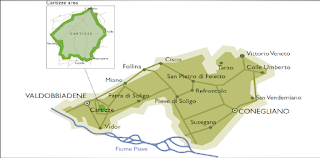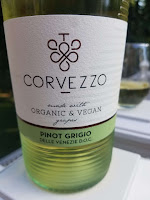With Friday October 26th being the
3rd Annual #ChampagneDay 2012, I thought it wise to draft a compendium of the sparkling wines from around the world. First, what is sparkling wine? Basically, it is still wine augmented with significant levels of carbon dioxide - thus the bubbles or fizz. Sparkling wine can be produced using one of two methods: (1) still wines undergo a second fermentation (in the bottle or in a sealed vat) or (2) CO
2 is directly injected into the bottled still wine. The traditional method (méthode champenoise) involves a second fermentation in the bottle where sugar and yeast are added to the bottle, triggering a second fermentation. "Through
the process of
riddling and eventually
disgorgement, the dead yeast cells (
lees) are removed from the wine while still maintaining the dissolved carbon dioxide gas." The Charmat method is the other secondary fermentation method which occurs in pressurized stainless steel fermentation tanks. The fresh yeast and sugar mixture is added to the wine in these tanks - basically an economies of size solution to the méthode champenoise. After secondary fermentation the wine is cooled, clarified and bottled using a counter pressure filler.
Champagne - is produced in the Champagne region of France using the méthode champenoise and most likely Chardonnay, Pinot Noir, and Pinot Meunier grapes. Chardonnay is prized for its finesse and aging ability. Pinot Noir adds body and fruit while Pinot Meunier contributes substantially to the aroma, adding fruit and floral notes. The majority of Champagnes produced are non-vintage (or rather, multi-vintage) blends.
Crémant - is sparkling wine produced using méthode champenoise in seven French appellations and one in Luxenbourg. In France, Crémant wines must be hand harvested within fixed yields and the resulting sparkling wine must be aged at least one year. In Luxenbourg, Crémant is produced in the Moselle district using the traditional method followed by at least nine months of aging.
- Crémant d'Alsace - produced from Pinot Blanc grapes, but may also contain Pinot Gris, Riesling, Pinot Noir and Chardonnay grapes.
- Crémant de Bordeaux
- Crémant de Bourgogne - produced in Burgundy and must be composed of at least thirty percent Pinot Noir, Chardonnay, Pinot Blanc or Pinot Gris grapes.
- Crémant de Die - produced in the Rhône Valley region using Clairette, Aligote and Muscat grapes.
- Crémant du Jura - produced in the Jura wine region, located between Burgundy and Switzerland. White and rosé wines can be produced from Poulsard, Trousseau and Pinot Noir red grapes and Chardonnay, Pinot Gris and Savagnin white grapes.
- Crémant de Limoux - produced in the Languedoc region, specifically in the villages surrounding Limoux and composed primarily of Mauzac (Blanquette de Limoux).
- Crémant de Loire - second largest producer of sparkling wine in France usually using a blend of Chardonnay, Chenin Blanc and Cabernet Franc.
- Crémant de Luxembourg - produced in the Moselle district using the traditional method followed by at least nine months of aging.
Cava - Spanish sparkling wine produced primarily around Catalonia. According to Spanish law, cava may be produced in eight wine regions: Aragon, the Basque Country, Castile and León, Catalonia, Extremadura, Navarra, Rioja or the Valencian Community. Cava can be
white or rosé (small quantities of Cabernet Sauvignon, Garnacha or Monastrell are added). Traditionally Cava is produced from indigenous Macabeu, Parellada, and Xarello grapes but may also contain Chardonnay, Pinot Noir and Subirat.
Prosecco - Italian sparkling wine made using the Charmat method and primarily Glera grapes harvested from Veneto and Friuli Venezia
Giulia.
Asti - Italian sparkling wine that is produced in southeastern Piedmont, particularly around the towns of Asti and Alba. The wine is made from the Moscato Bianco grape using the Charmat method and is generally sweet and low in alcohol.
Lambrusco - Italian sparkling wine produced using the Charmat method in four zones in Emilia-Romagna and one in Lombardy using six Lambrusco red varieties: Lambrusco Grasparossa, Lambrusco Maestri, Lambrusco Marani, Lambrusco Montericco, Lambrusco Salamino and Lambrusco Sorbara. All of these various Lambrusco grapes are indigenous to Emilia and neither clones nor sub-clones.
Franciacorta - Italian sparkling wine from Lombardy using a blend of Chardonnay, Pinot Noir, Pinot Blanc and using the méthode champenoise.
Sekt - German or Austrian sparkling wine produced usually using the Charmat method. Deutescher Sekt is produced exclusively from German grown grapes (Riesling, Pinot Blanc, Pinot Gris and Pinot Noir), whereas most Sekt is produced from imported grapes.In Austria, Sekt is produced from Welschriesling and Gruner Vetliner grapes.
Espumante - Portuguese sparkling wine produced throughout Portugal from the northern region of Vinho Verde to the southern region of the Alentejo.
Quality Espumante is produced solely in DOC Bairrada, located just south of Vinho Verde, using the méthode champenoise and made from quick-pressed red Baga or Touriga Nacional grapes, fragrant white Maria Gomes, Arinto, Bical and Chardonnay.
Pezsgő - Hungarian sparkling wine produced primarily using the Charmat method, but more recently the méthode champenoise using indigenous Olaszrizling, Kékfrankos, Furmint, Királyleányka, Hárslevelű, Kéknyelű and Juhfark or Chardonnay, Pinot Noir, Riesling, and Muscat Ottonel.
Penina - Slovenian sparkling wine made using the using the méthode champenoise usually from the Radgona-Kapela district (Drava Valley) or Bizeljsko-Brežice district ( Lower Sava Valley).
Australia - sparkling wine in Australia is usually made from Champagne grapes using the méthode champenoise with Tasmania and Victoria the most prized regions. Sparkling Shiraz is made from oak aged Syrah that undergoes secondary fermentation using méthode champenoise.
United Kingdom - sparkling wine is produced in the U.K. in Kent and Sussex counties using the méthode champenoise and from multiple grapes Seyval Blanc, Kerner, Müller-Thurgau; and to a lesser extent the Champagne grapes: Chardonnay, Pinot Noir and Pinot Meunier.
South Africa - South African sparkling wine is called Method Cap Classique, South Africa’s name for methode champenoise using traditional Champagne grape varieties.
United States: most American wineries produce sparkling wines using the methode champenoise and traditional Champagne grape varieties.
- Finger Lakes - cooler climate allows for more intense flavors at a lower brix measurement using Chardonnay, Pinot Noir and Riesling grapes.




















